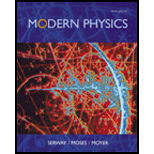
(a)
The distance from A of the impact points of molecules.
(a)
Answer to Problem 3P
The distance covered by molecules travelling at
Explanation of Solution
The molecule covers d distance in t time with the speed of v.
Write the expression for
Here,
Substitute
Here, d is the diameter of cylinder and v is the velocity of molecule.
Write the expression for distance covered.
Here, s is the distance covered.
Substitute
Write the expression for average velocity.
Here, m is the mass of gas molecule,
Write the expression for root mean square velocity.
Here,
Write the expression for most probable velocity.
Here,
Conclusion:
Substitute
Substitute
Substitute
Substitute 6250 for N,
Substitute 6250 for N,
Substitute 6250 for N,
Thus, the distance covered by molecules travelling at
(b)
The reason why
(b)
Answer to Problem 3P
The molecules of
Explanation of Solution
The momentum of
Conclusion:
Thus, the molecules of
Want to see more full solutions like this?
Chapter 10 Solutions
Modern Physics
- Suppose Fuzzy, a quantum-mechanical duck, lives in a world in which h = 2 J s. Fuzzy has a mass of 1.90 kg and is initially known to be within a pond 1.00 m wide. (a) What is the minimum uncertainty in the duck's speed? m/s (b) Assuming this uncertainty in speed to prevail for 4.90 s, determine the uncertainty in Fuzzy's position after this time. marrow_forwardWhat is the type of emission for a crystal transmits an E.M wave with 1GHz at room temperature?arrow_forwardThe Maxwellian distribution of speeds in 3d is maybe written as f„") =- exp (v, V7) 2kT n is the particle number density and m a. the average speed b. the rms speed sqrtarrow_forward
- The Maxwellian distribution of speeds in 3d is maybe written as n is the particle number density and the average speed <v> the rms speed sqrt<v2>arrow_forwardA pair of students measure the intensity of light from a desklamp in Sec. 4.5 of the experiment. When the detector is 25 cm from the lamp, the signal measured by the detector is 0.74 V. How large a signal (in V) do the students expect when the detector is 53 cm away?arrow_forwardA student performs the experiment and measures the distance between photogates: d = 50 ± 0.1 cm, the times measured by photogates: t0 = 0.052 ± 0.001s and t1 = 0.035 ± 0.001s, and the cart’s length: s = 10 ± 0.05 cm. Find the acceleration a of the cart and estimate uncertainty in a.arrow_forward
- Young's experimental setup can be used to monitor the width of the lead wires in transistors. The cables are placed in a narrow opening as shown in the figure. The opening is illuminated with highly coherent light. The position of the tenth maximum is measured on a screen located at 0.5m. The expected diameter of the wires is 0.100±0.005 mm. (a) What is the maximum deviation that the position of the tenth maximum can have so that the cable has an acceptable diameter? What would happen if the first maximum was used as the criterion, would the decision be easier or more difficult?arrow_forward......... In Maxwell Boltzman distribution, what is tne avorage kinetic energy mu)= Jmv°n(w)dv %3D S Using this result determine andarrow_forwardAssuming the dioder to be ideal is the figure for the output to be clipped, the simput voltag Vp must be outside the range. Vr (₂) AAAA toks Page ENV ✔ D₂A -2V + t loke V. ↓arrow_forward
- A highly collimated (parallel) beam of electrons is shot through a single slit of width 17.5μm. The electrons are moving with a speed of 7.357.35km/s. When they hit the screen, located at distance 1.57m away, the distribution of hitting positions makes a pattern with a central peak and minima on either side. What is the width of the central peak (equivalently, distance between the minima on either side)? The mass of an electron is 9.11×10^−31 kg.arrow_forwardIn the experiment by Jönsson, 50-keV electrons impinged on slits of width 500 nm separated by a distance of 2000 nm. The observation screen was located 350 mm beyond the slits. What was the distance between the first two maxima?arrow_forwardDiffraction effects become significant when the width of an aperture is comparable to the wavelength of the waves being diffracted. (a) At what speed will the de Broglie wavelength of a 65-kg student be equal to the 0.76-m width of a doorway? (b) At this speed, how much time will it take the student to travel a distance of 1.0 mm? (For comparison, the age of the universe is approximately 4 * 10^17 s.)arrow_forward
 Modern PhysicsPhysicsISBN:9781111794378Author:Raymond A. Serway, Clement J. Moses, Curt A. MoyerPublisher:Cengage Learning
Modern PhysicsPhysicsISBN:9781111794378Author:Raymond A. Serway, Clement J. Moses, Curt A. MoyerPublisher:Cengage Learning Principles of Physics: A Calculus-Based TextPhysicsISBN:9781133104261Author:Raymond A. Serway, John W. JewettPublisher:Cengage Learning
Principles of Physics: A Calculus-Based TextPhysicsISBN:9781133104261Author:Raymond A. Serway, John W. JewettPublisher:Cengage Learning

